
Nectarine U-Pick Orchards in Southeastern New Hampshire in 2024, by county
Below are the U-Pick orchards and farms for nectarines that we know of in this area.
Not all areas of a state have nectarines orchards that are open to the public. If you know of any others, please tell us using the add a farm form!
Remember to always check with the farm's own website or Facebook page before you go - or call or email them if they don't have a website or Facebook page. Conditions at the farms and crops can change literally overnight, so if you want to avoid a wasted trip out there - check with the farm directly before you go! If I cannot reach them, I DON'T GO!
PLEASE report closed farms, broken links and incorrect info using the "Report Corrections" form below.
Rockingham County
- Applecrest Farm Orchards, Inc. - - Apples, strawberries, vegetables, peaches and nectarines, make your own cider, and hayrides
133 Exeter Road, Hampton Falls, NH 03844. Phone: 603-926-3721. Email: info@applecrest.com. Open: 8 am to 6 pm. Click here for a map and directions. Fax: 926-0006 i Pick your own apples or pumpkins, make your own cider, and hayrides thru the orchards in the fall. We even offer a storybook hayride! STRAWBERRY FESTIVAL: Sunday, June 16, 2013 (10 am to 3 pm). Four rolling acres of juicy berries and a cool spring-fed pond provide the backdrop for a fun-filled day of Pick-Your-Own strawberries, free live bluegrass music, tractor drawn hayrides, face painting, cider donuts and a bevy of strawberry inspired delicacies from our very own scratch kitchen and bakery. Our Fall festivals launch on the first weekend in September and run from 11 am to 5 pm, both Saturday and Sunday, every weekend, through the end of October. Here's what you can expect: Pick-Your-Own Apples, Raspberries, Peaches & Pumpkins. Cut-your-own flowers too! FREE live Folk and Bluegrass music (1 pm - 5 pm. Old-Fashioned ice cream barn with 25 local-made flavors featuring our own grown-on-the-farm fruits. Horse-drawn Hayrides (10 am to 4:45 pm). Children's Petting Zoo (10 am to 4:45 pm). Face Painting & Balloons. Pie Eating Contests. Apple Pie & Ice Cream. Old-Fashioned Hot Cider Donuts. Make-your-own Scarecrow. Our Famous Corn Roast featuring: grilled gourmet sausages, hot dogs, hamburgers, fire-roasted corn, Maine clam chowder, fresh pressed apple cider and more. Early September is always a great time to Pick-Your-Own, as we have FOUR great offerings to choose from: Apples, Pumpkins, Raspberries & Peaches. A visitor writes on September 22, 2020: "Apples were $30/peck PYO"
Strafford County
- Butternut Farm LLC - apples, blackberries, blueberries, cherries, nectarines, plums, pumpkins, raspberries, strawberries, tomatoes, restrooms, picnic area, farm animals, school tours
195 Meaderboro Road, Farmington, NH 03835. Phone: 603 335-4705. Email: giffandmae@butternutfarm.net. Open: See our website for current hours because they vary depending on season. Directions: Take exit 13 off the Spaulding turnpike. Head west on rte 202 for 1 mile. At the blinking light turn right onto Estes Road Go for 4 miles through Meaderboro corner and we will be on your right. . Click here for a map and directions. Payment: Cash, Check. Fax: Picking updates: click here for picking updates. Crops are usually available in June, July, August, September, October We are a family run and family orientated Pick Your Own Fruit Farm. We pride ourselves on offering a clean farm and the best quality produce available. Typical harvest dates are: Strawberries mid June to early July. Raspberries in July. Sweet Cherries in July. Blueberries from late July through August. Peaches from late July through September. Apples from late August through October. Pumpkins in September and October. (UPDATED: August 10, 2013, by a visitor) A visitor writes on August 10, 2013: "little hard to find as their sign is a mini sign - if you take ( STRAFFORD ROAD - AKA 202a ) down Meaderboro Rd you will pass a lot of farms - Valley farm ( Apples ) Scuton Dairy ( milk ) 4 rod road the house is a sunny Yellow in color on the right - or from Farmington it is on left "
Comments from a visitor on June 30, 2011: "I just loved this farm. A great Family run farm. Prefect for families with small children. The strawberries we pick were the biggest sweetest I have ever picked. Look forward to apples and raspberries picking."
Comments from a visitor on October 03, 2010: "Farm is beautiful! I've never seen such big, beautiful apples. Great place for the whole family and tons of fresh produce. Many varieties of apples to choose from. Will certainly return." - Ridge Runner's Farm - Flowers, raspberries, blueberries, peaches & nectarines, fresh dug perennials
16160 Ridge Road Top, New Durham, NH 03855. Phone: 603-859-7840. Email: ridgerunnersfarm@gmail.com. Open: Tuesday through Sunday, from 8:30 am to 4:30 pm; they expect to stay open through the first week of September, but conditions can always change, so always call ahead. Click here for a map and directions.
Ridge Runner's Farm Facebook page. Note: 2013 will be their last year in business. See this news story(UPDATED: August 18, 2013) - Tuts Blueberries - Uses integrated pest management practices, apples, blackberries, blueberries, nectarines, pears, peaches, plums, pumpkins, raspberries (red), Maple Syrup from trees on the farm, Cider mill fresh apple cider made on the premises, restrooms
64 Bolan Rd, Milton, NH 03851. Phone: (603) 652-8380. Email: tutsblueberries51@gmail.com. Open: Monday to Friday, 8am to 5 pm; Saturday and Sunday 8am to 4pm, from July1 to October1. Directions: Spaulding turnpike exit 17E,east on route 175 1 mile, left on route 125 north 4 miles right on Bolan road one half mile the farm is on the right. . Click here for a map and directions. Payment: Cash, Check, Debit cards, Visa, MasterCard, Discover. Blueberry picking is usually July 15 to September 1;. We use integrated pest management practices(ADDED: August 05, 2021) (ADDED: July 01, 2015)
Nectarine
Nectarine Picking Tips, Recipes and Information
Nectarines typically peak during early summer: In the U.S., that's late June through July in the South, and July and August in the North. In order to produce good local Nectarines, producers depend on ideal spring and early summer weather conditions, and no late frosts. If you want to know which are the best varieties of nectarines for home canning, see this page!
Before you leave to go to the farm:
- Always call before you go to the farm - Nectarines are affected by weather (both rain and cooler temperature) more than most crops. And when they are in season, a large turnout can pick a field clean before noon, so CALL first!
- Leave early. On weekends, then fields may be picked clean by NOON!
-
Most growers furnish picking containers designed for nectarines, but they may
charge you for them; be sure to call before you go to see if you need to
bring
containers.
If you use your own containers, remember that heaping Nectarines more than 14 inches deep will bruise the fruit on the bottom. Plastic dishpans, metal oven pans with 3 inch tall sides and large pots make good containers.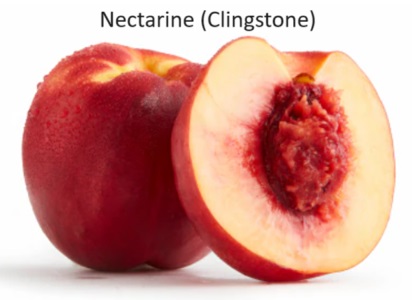
- Bring something to drink and a few snacks; you'd be surprised how you can work up a thirst and appetite! And don't forget hats and sunscreen for the sun. Bugs usually aren't a problem, but some deet might be good to bring along if it has been rainy.
- You might want to ask whether the nectarines are! There are two major types of nectarines: "Freestone" and. "Clingstone". Freestone nectarines and nectarines have flesh that slips easily away from the pit. Clingstones are a REAL pain, because the fruit tenaciously clings to the stone or pit! Most nectarine varieties grown today are freestone and are usually available (depending upon your location) from June through September. Some nectarines are freestone and some are clingstone. Freestone nectarines are available in June and July. Most plum varieties are clingstone.
When you get home
-
Spread the fruit out on towels or newspapers and separate any mushy or
damaged fruit to use immediately.
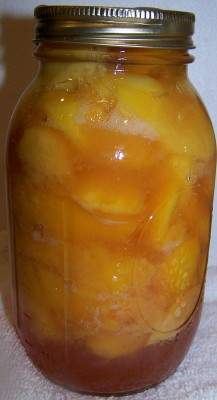
- Put a couple of days supply into the fridge, wash and cut the others and freeze them up!
- Even under ideal conditions nectarines will only keep for a week in a refrigerator, so for best flavor and texture, use them as soon as possible after purchase
- Now, get ready to make Nectarine jam or canned nectarines - It is VERY easy -
especially with our free peach / nectarine recipes. Yes, they are interchangeable!
- nectarine jam instructions - they're illustrated and easy and our page on
- how to make home canned nectarines from fresh!
- Or see here to freeze nectarines instead!
- make your own home canned nectarine pie filling to use in the winter - Here's a great and easy nectarine pie
recipe
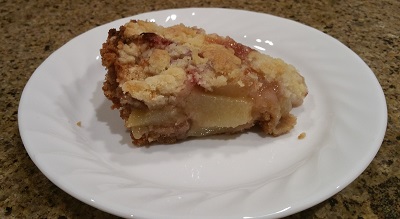
or nectarine-blueberry pie or how about
- nectarine salsa?
- Nectarine chutney
- Spiced nectarines
- nectarine butter
- Nectarine honey
- pickled nectarines
- nectarine syrup
- nectarine juice - Here are some great and easy
nectarine desert recipes, like easy
nectarine cobbler.
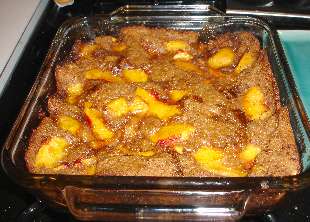
- If you want more information about the Giant Peach water tower in Gaffney, SC, click here.
Temporary Storage Tips
- Ripe nectarines have a creamy or golden undertone and "peachy-sweet" fragrance.
- Nectarines should be refrigerated and used within a few days.
- Putting peaches and nectarines in a loosely closed paper bag at room temperature for a day or two can help soften firm fruit - but they won't become sweeter or ripen further - that stopped when they were removed from th etree.
- For best flavor, allow the fruit to ripen fully on the tree.
- Store at 33F to 40F and high humidity (a vegetable drawer in the fridge).
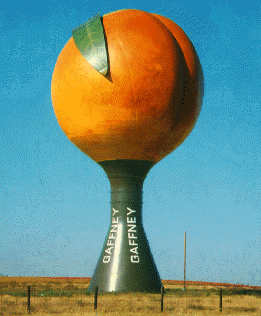
How to tell if the nectarines are ripe!
- Attached to the tree: Nectarines are best picked when the fruit separates easily from the twigs. If it is hard to pull off the tree, it isn't ripe! Nectarines will not ripen further once removed from the tree (they only "soften")
- Color: Green is definitely unripe, but you can't use red color as an indicator of how ripe a nectarine is. Different peach varieties have differing amounts of red blush in their natural coloring. Pick them when the ground color changes from green to yellow, orange, red (or a combination). The skin of yellow-fleshed varieties ripens to an orange tint, while the skin of white-fleshed varieties changes from greenish- to yellow-white.
- Softness: unless you like your nectarines very firm, pick your nectarines with just a little "give" when gently pressed. Nectarines at this stage are great for eating, freezing, and baking. Nectarines won't ripen very much after picking!
- Odor: It should smell sweet and ripe!
Tips on How to Pick Nectarines
A nectarine is softer than most fruit, so it is important to pick a nectarine gently, with little pressure. Using the sides of your fingers rather your fingertips helps to avoid bruising. Grab the nectarine firmly and pull it straight off the branch. DON'T drop the nectarine into the basket, but set it in gently!
Marks on the Nectarines: Bugs (particularly squash bugs and stink bugs) bite fruit during development and this results in some imperfections in the nectarine. This is especially the case with organically raised fruit. These look like dents in the nectarines if the nectarines were bitten by a bug when they were young. This causes a spot that does not grow properly and makes a wrinkle in the nectarine. There's nothing wrong with these nectarines. They may look funny, but they will taste just as good as blemish-free nectarines, and it's better not to have the pesticides!

How much do you need?
Raw measures:
- About 2 medium nectarines = 1 cup sliced nectarines.
- About 4 medium nectarines = 1 cup pureed nectarine.
- About 3 medium nectarines = 1 pound of nectarines
Process yields (Raw amounts to processed amounts)
- 2 to 21/2 pounds of fresh nectarines yields 1 quart canned
- 1 lb of fresh nectarines typically yields 3 cups of peeled, sliced nectarines or 2 cups or puree.
- It takes about 5 good sizes peaches or nectarines (or about 10 plums) to fill one quart jar of canned nectarines.
- An average of 171/2 pounds of fresh nectarines are needed per canner load of 7 quarts;
- An average of 11 pounds is needed per canner load of 9 pints.
- 1 bushel = 48 to 50 pounds, yields approximately 18 to 25 quart jars.
And a visitor contributes this: 6-7 nectarines makes about 4 cups puree, so 2-3 nectarines make about 2 cups puree. 1 nectarine equals about 1 cup puree.
Nectarines - Average retail price per pound and per cup equivalent, Most recent data (2020)
| Form | Average retail price *3 | Preparation yield factor | Size of a cup equivalent | Unit | Average price per cup equivalent | |
| Fresh *1 | $1.72 | per pound | 0.96 | 0.342 | pounds | $0.61 |
| Canned | ||||||
| Packed in juice *2 | $2.02 | per pound | 1 | 0.540 | pounds | $1.09 |
| Packed in syrup or water *3 | $1.81 | per pound | 0.65 | 0.441 | pounds | $1.23 |
| Frozen | $3.39 | per pound | 1 | 0.331 | pounds | $1.12 |
| Note 1 - The USDA National Nutrient Database for Standard Reference (SR) reports that the inedible pit of a nectarine accounts for 4 percent of the retail weight, implying a preparation yield of 96 percent, when eaten raw. | ||||||
| Note 2 - Consumers are assumed to eat the solid fruit and drink the juice. All contents of the can are edible and count towards an individual's recommended fruit consumption. | ||||||
| Note 3 - The syrup (or water) is discarded prior to consumption. Based on the Food Patterns Equivalents Database (FPED), ERS assumes that 65 percent of the can's gross weight is solid and 35 percent is liquid. The FPED cup equivalent weight for canned fruit is the weight of the solids and not of the liquid medium in which it is packed. The preparation yield factor for canned nectarines in the above table does not account for any further preparation that occurs prior to consumption. | ||||||
| Source: USDA, Economic Research Service calculations from 2020 Circana (formerly Information Resources, Inc. [IRI]) OmniMarket Core Outlets (formerly InfoScan) data; the USDA National Nutrient Database for Standard Reference (SR), Legacy Release; and the Food Patterns Equivalents Database (FPED) 2017–18 as well as the FPED's accompanying Methodology and User Guide. | ||||||
---
Nectarine pit tips
It's best to remove nectarine pits before you cook the nectarines. Cherry, nectarine, peach, and apricot pits also contain amygdalin; the latter two, in potentially harmful amounts. Fortunately, nectarine, peach and apricot pits are sufficiently large and hard that few people intentionally swallow or chew them. (The unapproved anti-cancer drug See this page for more information&URL=http%3A%2F%2Fwww.cancer.gov/cancerinfo/pdq/cam/laetrile">Laetrile is a semisynthetic derivative of amygdalin; a cheaper version of laetrile produced in Mexico came from crushed apricot pits.) See this page for more information.
Other Local Farm Products (Honey, Horses, Milk, Meat, Eggs, Etc.)
(NOT pick-your-own, unless they are also listed above)
- Farm markets and roadside stands
- Local Honey Finder
- Local Meat, Milk and Eggs
- Venues: Farms, Wineries, Orchards for your event, wedding or party
- Easter egg hunts
- Children"s consignment sales
- Fruit and vegetable festivals
- Winery tours and wine tastings
- Horse rides, stables, lessons, trails
- Maple Syrup farms and sugarworks
- Bed & Breakfasts on Farms, Wineries, Ranches and Orchards
- Pumpkin patches
- Corn mazes
- Zombie Paintball venues
- Christmas Tree Farms & lots
- Environmental resources
- Consumer fraud information
- Wholesale food sources
- Resources for Farmers
Looking for canning equipment and supplies?
Water bath canner with a jar rack
Pressure canners for gas, electric and induction stoves: Presto 23Qt or T-fal 22Qt
Canning scoop (this one is PERFECT)
Ball Blue book (most recent version)
Jars: 8oz canning jars for jams
Find Other types of farms:
Farm markets and roadside stands
Road trips and camping resources
Local Honey, apiaries, beekeepers
Consumer fraud and scams information
Home canning supplies at the best prices on the internet!
Maple Syrup Farms, sugarworks, maple syrup festivals
Environmental information and resources
Farms For Your Event for birthday parties, weddings, receptions, business meetings, retreats, etc.
Festivals - local fruit and vegetable festivals
Get the
most recent version of
the Ball Blue Book
With this Presto 23 quart pressure canner and pressure cooker, you can "can" everything, fruits, vegetables, jams, jellies, salsa, applesauce, pickles, even meats, soups, stews. Model 01781

You can make jams, jellies, can fruit, applesauce, salsa and pickles with water bath canners, like this Granite Ware 12-Piece Canner Kit, Jar Rack, Blancher, Colander and 5 piece Canning Tool Set

